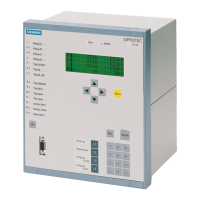Functions
2.2 Protection Data Interfaces and Protection Data Topology
SIPROTEC, 7SD610, Manual
C53000-G1176-C145-6, Release date 02.2011
59
2.2.3 Protection Data Interfaces
2.2.3.1 Setting Notes
General Information about Interfaces
The protection data interfaces connect the devices with the communication media. The communication is per-
manently monitored by the devices. Address 4509 T-DATA DISTURB defines after which delay time the user
is informed about a faulty or missing telegram. Address 4510 T-DATAFAIL is used to set the time after which
a transmission failure alarm is output. Address 4512 Td ResetRemote determines how long remote signals
remain standing after a communication disturbance.
Protection data interface 1
The protection data interface 1 can be turned ON or OFF in address 4501 STATE PROT I 1. If it is switched
OFF, this corresponds to a communication failure. The differential protection and all functions which require the
transmission of data, cannot work in this case.
In address 4502 CONNEC. 1 OVER, set the transmission media that you want to connect to protection data
interface PI 1. The following selection is possible:
F.optic direct, i.e. direct communication by fibre-optic cable with 512 kbit/s;
Com conv 64 kBit/s , i.e. via communication converters with 64 kbit/s (G703.1 or X.21);
Com conv 128 kBit/s, i.e. via communication converters with 128 kbit/s (X.21, copper cable);
Com conv 512 kBit/s, i.e. via communication converter 512 KBit/s (X.21) or communication converter for
2 MBit/s (G703-E1/T1);
IEEE C37.94, i.e. communication network connection with 1, 2, 4, or 8 slots.
The setting options depend on the parameterization of the functional scope and on the device variant. The data
must be identical at both ends of a communication route.
The setting depends on the properties of the communication medium. Generally, the response time of the dif-
ferential protection system is shorter the higher the transmission rate.
The devices measure and monitor the transmission times. Deviations are corrected as long as they are within
the permissible range.
The maximum permissible transmission time (address 4505 PROT 1 T-DELAY) is preset to a default value
that does not exceed the usual delay of communication networks. This parameter can only be set in DIGSI at
Display Additional Settings. If it is exceeded during operation, for example, because of switchover to a dif-
ferent transmission route, the message „PI1 TD alarm“ (No. 3239) will be issued. The protection data in-
terface and the differential protection continue being in operation! Increased transmission times only have an
impact on the tripping time of the differential protection and therefore on the fault clearance time.
The maximum transmission time difference (outgoing signal vs. return signal) can be changed in address
4506 PROT 1 UNSYM.. This parameter can only be set in DIGSI at Display Additional Settings. The devices
assume symmetrical transfer times after establishing or re-establishing a connection. The maximum runtime
difference is considered as the maximum fault of synchronisation when calculating the restraint current.
